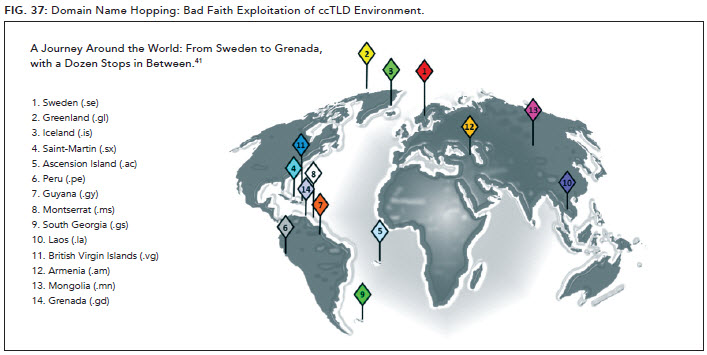The Office of the U.S. Intellectual Property Enforcement Coordinator (IPEC) released the 2017-2019 U.S. Joint Strategic Plan on Intellectual Property Enforcement titled “Supporting Innovation, Creativity & Enterprise: Charting a Path Ahead.”
The US government plans to stop domain name hopping, that is changing to a different domain name after one is suspended for various reasons.
This document charts the course for work to be carried over the next three years by the federal government—with opportunities for state and local governments, foreign governments, and the private sector—in support of a strong policy environment for intellectual property enforcement.
“The U.S. State Department collaborated with the IPEC and counterparts in other government departments in crafting this plan, which highlights the cultural and economic importance of creative and innovative communities. These sectors support over 45 million U.S. jobs, generate more than 50 percent of our exports, and enrich our cultural landscape.
The State Department’s Office of International Intellectual Property Enforcement promotes American and global innovation by advocating for the protection and enforcement of intellectual property rights (IPR) around the world. The office works with economic officers at the State Department’s embassies, consulates, and missions to ensure that the interests of U.S. rights holders are represented overseas, and to highlight the vital role of IPR protection in the global economy.”
Motion Picture Association of America (MPAA) partnership with Donuts and Radix
The plan mentions the partnership between the Motion Picture Association of America (MPAA) and the Donuts and Radix registries.
“This Strategic Plan has identified numerous circumstances where enhanced non-governmental leadership and public-private sector collaborations may yield beneficial results. Over the past few years, for example, several private-sector-led collaborative partnerships have emerged—comprised of leading Internet service providers, content producers, and brand owners, payment processors, advertisers, and ad networks, domain name registries, and others—with the laudable goal of minimizing the criminal exploitation of a business’s services or platforms by syndicates perpetrating consumer frauds and other illicit activities.”
“Domain Name Registry Best Practices, launched in partnership with the Motion Picture Association of America (MPAA) and the Donuts and Redix domain name registry platforms, works to promote a safe and secure domain name system. Under the program, a “trusted notifier” system has been established as part of collaborative efforts to mitigate blatant and pervasive illegal online activity in violation of platform terms of service.””
The plan mentions how unlawful entities can register domain names using false registration information.
“Entities engaged in the unlawful exploitation of copyrighted content are reported to conceal or otherwise mask identifying information by providing false or inaccurate registration information when registering a domain name. An operator of a website engaged in illicit activity may also employ one or more evasive registration tactics (FIG. 2,3) such as the registration of hundreds of names across various jurisdictions, in order to increase resilience against any enforcement actions directed at the illicit enterprise.
Once domain names have been secured, reporting suggests that the entity seeking to exploit unlicensed third-party content for commercial profit often employs various additional hosting and operational schemes in an attempt to shield the illicit enterprise from effective enforcement. ”
In Furtherance of a Healthy Domain Name System (Assessing the Enforcement Challenge of Domain Name Hopping)
Finally there is a whole section (page 68) dedicated to domain name hopping:
For purposes of this section, the Administration has directed its focus to detailing some of the reported tactics used by criminal actors in the online environment and the corresponding enforcement challenges. In observance of the established global multistakeholder approaches used to address domain name issues and the National Telecommunications and Information Administration’s (NTIA) role as the convener of the U.S. government’s DNS interagency working group which establishes U.S. policy positions on domain name issues broadly and with respect to the Internet Corporation for Assigned Names and Numbers (ICANN), including the Governmental Advisory Committee (GAC) and
its working groups, the U.S. Interagency Strategic Planning Committees on IP Enforcement reaffirms the principle that the “U.S. Government remains dedicated to working within the multistakeholder construct at ICANN and all relevant venues to vigorously defend and advance U.S. interests.”
It has been reported that entities engaged in online counterfeit sales, the unlawful exploitation of copyrighted materials, and other large-scale infringing activity may engage in a combination of “domain name hopping” and “venue shopping” for perceived domain name safe havens. These tactics have been reported within both the gTLD and ccTLD domain name environments.
Top Level Domains (TLDs) are those strings of characters that follow the last ‘dot’ in a domain name, for example “.gov” in www.whitehouse.gov. TLDs are typically divided into two categories: generic Top Level Domains (gTLDs) and country code Top-Level Domains (ccTLDs). gTLDs are those TLDs of three or more characters, the operators of which typically have contractual agreements with ICANN. ccTLDs are those TLDs representing two-letter abbreviations for countries and territories, such as .us for the United States or .io for the British Indian Ocean Territory, delegated under policies developed by the Internet Engineering Task Force’s Request For Comment (RFC) 1591.36 The relationship between any given ccTLD administrator and its government will differ from case to case and may depend on complex and sensitive arrangements particular to the local political climate. Different ccTLD policies will reflect different approaches with respect to process for the suspension, transfer, or cancellation of a domain name registration. Some ccTLDs use the same dispute resolution mechanism as gTLDs do – the Uniform Domain Name Dispute Resolution Policy – while others tailor their own variations of this policy.
While the TLD environment provides Internet users with a diversity of choice, operators of websites engaged in illicit IP-based activities exploit this openness. To evade law enforcement, bad actors will register the same or different domain name with different registrars. They then attempt to evade law enforcement by moving from one registrar to another, thus prolonging the so-called
“whack-a-mole” pursuit. The result of this behavior is to drive up costs of time and resources spent on protecting intellectual property rights.
By way of illustration (FIG. 37), an operator of a large file-sharing site found guilty of facilitating criminal peer-to-peer file sharing of movies, music and games continued to circumnavigate the globe and exploit the domain name environment by moving from ccTLD to ccTLD to evade law enforcement.
In the “Notorious Markets” Out-of-Cycle Review, the Office of the U.S. Trade Representative lists illustrative markets facilitating counterfeiting and piracy. In the lists from 2013-2015, a total of 26 of 54 named sites, or almost half of named online sites, operate within the ccTLD environment. Based on the most recent Notorious Markets lists available prior to issuance of this plan, ccTLDs comprise roughly half of all named “notorious” top-level domains.39 Considering that ccTLDs are outnumbered by gTLDs in the domain name base by more than a 2-to-1 ratio, the frequency of bad faith ccTLD sites appear to be disproportionate in nature and worthy of further research and analysis.
ACTION NO. 2.9: Continue to assess the nature of abusive domain name registration tactics and identify opportunities to minimize criminal activity. As part of a multistakeholder process aimed at crime prevention and the protection of public health, safety, and consumer welfare, the U.S DNS Interagency working group will work with the Interagency Strategic Planning Committees on IP Enforcement, to assess the scope of abusive domain name registration tactics and trends, and consider appropriate opportunities to work with stakeholders to curb criminal activity.
To read the complete plan, please visit: https://www.whitehouse.gov/sites/default/files/omb/IPEC/2016jointstrategicplan.pdf.
 OnlineDomain.com Domain Name News & Opinions
OnlineDomain.com Domain Name News & Opinions




“U.S. Government remains dedicated to working within the multistakeholder construct at ICANN and all relevant venues to vigorously defend and advance U.S. interests.”
So this administration just gave away veto power to the ICANN multistake model and now wants to “vigorously” defend U.S. interests…The same administration (Obama) is going around and saying cyber security is now a real threat….You can’t make this stuff up folks.